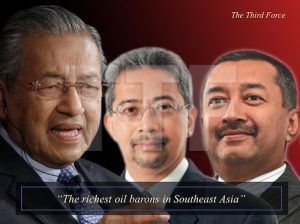
TTF: On the 1st of June 2018, I wrote an article titled, “Petron, Mirzan, Mokhzani and Mahathir – the richest oil barons in Southeast Asia (Part One)” (READ FULL ARTICLE HERE). In the article, I gave proof of Mirzan Mahathir’s ownership of Petron Malaysia (PEM) and its parent concern, Petron Corporation. Mirzan is also a stakeholder in San Miguel Corporation, a Philippines based food and beverage giant that owns 68.3 percent of Petron Corporation.
The son of Dr Mahathir Mohamad, Mirzan has somewhat of an exclusive say in the way Petron’s retail is handled across the Peninsula of Malaysia, Sabah and Sarawak. He does not, however, have access to ExxonMobile’s oil exploration, extraction, shipping and wholesale operations, activity that brings in ten times more profit than retail. That access was provided to him in 2013 though through a massive network of associations that involved his brother, Tan Sri Mokhzani Mahathir.
On the same day, I wrote (in orange):
Mokhzani’s father, Mahathir, was sore that Najib had not revived plans to build a crooked bridge to replace the Malaysian side of the Johor-Singapore causeway. The whole purpose of the bridge was to force Singapore into renegotiating Maritime Security arrangements with Malaysia in ways that would grant our country access to oil rich areas at the edge of the South China Sea. Najib’s refusal to revive the project made dealing with Petronas less appealing. While Mahathir sat contriving plans to oust Najib as a measure of vendetta, Mokhzani turned to his childhood friend and longtime associate, Tan Sri Shahril Shamsuddin.
Shahril was then the co-owner of his family telecommunications concern, Sapura. In 2011, he undertook in a massive RM12 billion deal with Mokhzani to merge SapuraCrest Petroleum Bhd with Kencana. The deal came to be known as “the largest ever in the history of corporate Malaysia” and resulted in the establishment of SapuraKencana (SK) Petroleum, an integrated oil and gas service and solutions provider. Late in 2012, both Shahril and Mokhzani turned Seadrill Ltd into SK’s second largest shareholder by getting the Bermuda based deepwater drilling company to part with 49 percent of its stake in the tender-rig business.
The deal cost SK USD2.9 billion and earned the company substantial control of the tender-rig market, then estimated to be worth some USD2 trillion. Seadrill’s owner, a Norwegian tycoon named Fredriksen, hopped on to SK’s board and helped Shahril secure some terms of associations with ExxonMobil and Chevron. That immediately turned SK into one of the world’s largest integrated oil and gas services and solutions provider and offered Mokhzani an opportunity to tap into ExxonMobil’s upstream business.
With the help of some nominee concerns that had direct and beneficial ownerships in oil related companies, Mokhzani was able to penetrate the exploration, extraction, shipping, and wholesale part of ExxonMobile’s operations, which, in Malaysia and Indonesia alone, covered an expanse of over 1.3 million acres. That gave Mahathir’s sons significant control of ExxonMobil’s upstream and downstream business within the region and turned them into the richest and most manipulative oil barons there were in Southeast Asia.
San Miguel has since indicated its willingness to purchase state-owned assets in Malaysia (see news item below). Unbeknownst to Malaysians, the Mirzan concern is eying Petronas and intends to sink its teeth into a major chunk of its shareholding. With the acquisition of Petronas, the Malaysian oil and gas industry would be monopolised by Mirzan and Mokhzani who’d then perform deep sea drilling along the the edge of the South China Sea.
For that to happen, Mahathir would first have to fast track the building of a new island where the once disputed Middle Rocks cluster stands. Once completed, both Malaysia and Singapore would be left with little option but to redefine security borders around the Straits of Singapore. Mahathir would then hold his Singaporean counterpart at ransom by seeking renegotiations of the Johor-Singapore water agreements (1961 and 1962), the Wayleave Agreements, and the agreement that Malaysia, Singapore and Indonesia jointly signed in October 2017 to improve security around the Malacca and Singapore Straits.
Assuming things go as planned, the Mahathirists will turn from being the richest oil barons in Southeast Asia to being the richest oil barons in the world. The Third Force will come up with part two of the aforementioned article to detail the exact plan Mahathir has in mind.
PETALING JAYA: San Miguel, the Philippines’ largest company by sales, plans to buy state-owned assets in Malaysia, as the government of Prime Minister Dr Mahathir Mohamad looks to trim the country’s debt, the Nikkei Asian Review reported.
The Japanese business publication quoted San Miguel president and chief operating officer Ramon Ang as saying he expected the Malaysian government to unload some of its assets following revelations of the country’s RM1 trillion debt.
Mahathir estimated last month that Malaysia’s national debt was equivalent to 65% of the economy, higher than the 50.8% level at end-2017 claimed by his predecessor, Najib Razak.
After taking power last month, Mahathir vowed to cut down debt and restore the country’s reputation.
“I think they will be doing a lot of privatisation so it looks like there are opportunities,” Ang told the Review.
He said San Miguel was particularly interested in the oil and power sectors.
San Miguel has a presence in Malaysia through Petron, its fuel refinery and retailing arm.
Petron’s net sales rose 21% to US$2.43 billion (RM9.6 billion) in the first three months of 2018 compared with a year ago. However, volume was flat at 26.6 million barrels amid higher global oil prices and a new excise tax over the same period.
Petron’s revenues account for half of San Miguel’s total sales.
Petron expanded in Malaysia in 2011 when it acquired the Malaysian businesses of ExxonMobil. It now operates 600 service stations and its Port Dickson refinery which produces 88,000 barrels per day.
Last year, Petron said it would invest US$3.5 billion to expand the refinery’s capacity to 178,000 barrels per day.
Source: Malaysian Digest
Note: If everyone who likes our content helps fund it, it would help us bring more such content in the future. For as little as RM10, you can support The Third Force, and it only takes a minute. Click the donate button on the top right or follow the link HERE if you intend to make a contribution. Thank you.



